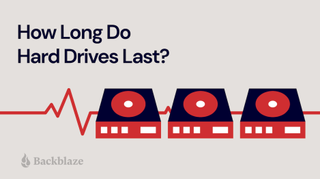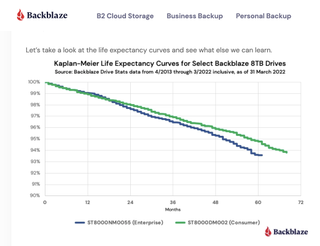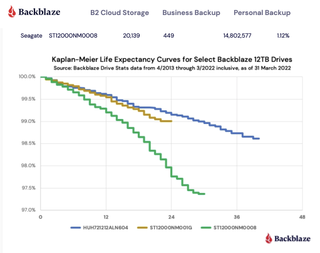Backblaze Reveals Life Expectancy for HDDs in Its Servers, Going Back to 2013
Do higher capacities actually provide longer lifetimes?

Cloud storage company Backblaze is at it again, providing consumers with interesting, practical data on what they can expect from their hard disk drive (HDD) investments. In this case, the company looked at life expectancy data for all the major-brand HDDs within its servers, including products from companies likeHGST, Seagate, Toshiba and WDC (Western Digital). This, statistically at least, answers that all-important question of "how long will this hard drive last me?" The results? As we've been showing you over years of reviews and Best Pick articles, there's more to a product than its sticker price and brand-name might suggest. Mileage across HDD brands varies wildy - sometimes even among models and across capacities . Backblaze was generous enough to provide data on various 4 TB, 8 TB, 12 TB and 14 TB hard drives.
Backblaze took its analysis as far back as April 2013, and analyzed all hard drives they've commissioned into work in a high enough number that allowed them to apply the Kaplan-Meier life expectancy curve. This curve, which has its roots in biological science, takes into account the number of subjects that have survived a treatment among all those that received it. There's no issue in applying it to other fields - as it often is. In the case of Backblaze's analysis, the "treatment" is the moment these hard drives start running. Unsurprisingly, some of them did die before the deadline for the gathered data, March 31st 2022.
Backblaze's analysis for 4 TB hard drives focused on two models: The HGST HMS5C4040BLE640 (sold as HGST MegaScale) and the Seagate ST4000DM000 (sold simply as a desktop HDD, which were operational from 2013 through 2015. As a note, HGST was absorbed by Western Digital Corporation (WDC) back in 2012, but hard drives with their stickers are still available for purchase.

Looking at Backblaze's graph, one would think that buying a 4 TB Seagate HDD would be bad idea; that drop is scary, even if does mean that 81% of the Seagate drives survived. You can also look at these life expectancy rates from another angle: 81% of the drives surviving means that 19 out of every 100 Seagate drives failed. As to HGST, 97 out of 100 usrvived.
Compared to HGST's much more respectable 97% survival rate, Darwin's survival of the fittest term comes to mind. But as you know, there are many more things that go into a purchase decision other than "How long will this part last me?".
Things like "How does it perform?", "How easy is it to buy" and more importantly, "How much does it cost?" are unavoidable questions for consumers looking for the best bang for their buck.
In this case, the HGST drives cost between 1.2 and 1.5 times more than the equivalent-capacity Seagate. The Seagate drives were also easier for Backblaze to purchase. We also have to take into account product positioning: HGST's drive belongs in the Enterprise segment, where reliability is paramount. The same isn't true for the "Desktop HDD" Seagate drives. These elements help explain both the difference in cost and the higher reliability of one drive over the other, and highlight the difficulties in choosing the right piece of hardware for any one of us.
Stay on the Cutting Edge
Join the experts who read Tom's Hardware for the inside track on enthusiast PC tech news — and have for over 25 years. We'll send breaking news and in-depth reviews of CPUs, GPUs, AI, maker hardware and more straight to your inbox.
Backblaze, of course, has other metrics they have to consider. While the average consumer would simply swap the failed drive and be done with it, Backblaze's scale means they replaced around 4,200 more failed Seagate drives than the HGST counterpart - 700 more drives a year, or around two more drives per day. At an estimated 30-40 minutes per day, that's a lot in technician-hours.

At 8 TB, Backblaze compared two Seagate drives: the consumer-geared ST8000DM002, and the enterprise-focused, Seagate Exos-branded ST8000NM0055. What's most interesting between these models is that they defy your expectations: The consumer drive showcases a better life expectancy than the enterprise model!
At odds with the general product segmentation - and sometimes mission-critical usage of Enterprise drives - this means that the two-year warranty on the first drive is slapped on a model that's actually more reliable than the five-year-protected Exos drive. In general, Backblaze's data shows that 95% of the consumer-geared "Desktop HDD" survived, compared ot 93.6% of the Exos models.

For the more data-driven users that either take large numbers of photographs (like me), work with content production, or generally just want to have more available space for their media or household backups, 12 TB drives is where the business gets serious. In this category, Backblaze again compared drives from Seagate - the Exos X14 (ST12000NM0008) and the Exos X16 (ST12000NM001G) against one HGST drive, the HGST HUH721212ALN604, (which may also be found with a Western Digital sticker, by the way).
As a rule of thumb, the higher the drive capacity, the more recently it was manufactured. With that in mind, evolving technology in the HDD space means that these have much better life expectancy rates than the lower-capacity ones. All three models showed a 98% life expectancy, and all of them carry the same five-year warranty. With the survival scores being what they are, that's one less factor to consider when choosing the best model for you. You can now give more weight to pricing and/or performance.


As for the 14 TB models, Backblaze managed to compare life expectancy for all three major HDD brands operating today: Toshiba (MG07ACA14TA, enterprise); WDC (WUH721414ALE6L4, marketed as the UltraStar DC HC 530); and Seagate's Exos X16 again (ST14000NM001G). All of them showcased excellent reliability, with an over 99% life expectancy across brands. Seagate once again was trailing the other manufacturers, but the margin here is so slim that it's mostly negligible. Compare 1% failure rates for Seagate's 14 TB HDD with the 19% failures of the 4 TB model mentioned in this article, and you'll see how far the company - and HDD tech in general - has come.
But that third place may be at risk of change, as the acceleration of failure rates in the Toshiba drives (the red line) does suggest increased failures than would be expected starting from around the 20-month mark. That's something to keep in mind, and also something Backblaze is likely to cover in future blog posts.
All in all, Backblaze's data provides an interesting, data-supported insight into the world of HDDs from its position as a cloud provider. Consumers too have interesting insights they can glean from these numbers: It seems that Western Digital disks are generally more reliable than Seagate's, although again, pricing is king when failure rates are as low as they are for models starting from the 12 TB mark.
That consumers can still find HSGT-branded hard drives in the market for the lowest capacity options showcases the fact that higher-capacity HDDs are far more likely to have a more recent manufacturing date, taking advantage of improvements to manufacturing technologies. That all by itself might be a good reason to pay a bit more and opt for higher capacity HDDs--especially if you're just buying a drive or two to store data you don't want to lose. But don't forget to back that data up, preferably in multiple places, with one off-site to safeguard against natural disasters.

Francisco Pires is a freelance news writer for Tom's Hardware with a soft side for quantum computing.
-
drtweak Toshiba. Eww. I stay away from anything Toshiba anymore. They use to be a good brand, but now just all down hill. When we would get a Dell with a Toshiba drive, I would either 1) swap it with a SSD or 2) take a seagate/wd pull from another dell that had a SSD upgrade and toss it in there. Way too many failures for me. More than Seagate and WD combined in my experience and Toshiba is only like 10-20% of OEM drives that have come across my desk.Reply -
helper800 Reply
In my experience its better to just toss the entire dell computer in the trash, unless its a laptop.drtweak said:Toshiba. Eww. I stay away from anything Toshiba anymore. They use to be a good brand, but now just all down hill. When we would get a Dell with a Toshiba drive, I would either 1) swap it with a SSD or 2) take a seagate/wd pull from another dell that had a SSD upgrade and toss it in there. Way too many failures for me. More than Seagate and WD combined in my experience and Toshiba is only like 10-20% of OEM drives that have come across my desk. -
smn19 ReplyCompare 1% failure rates for Seagate's 14 TB HDD with the 19% failures of the 4 TB model
You need to compare the same number of months -
Rdslw Reply
Still by the trends newer and bigger drives last longer. If we include 2TB/3TD drives in to that graph from 2008 or so, then they all died within 3 years if I remembersmn19 said:You need to compare the same number of months
I am not sure if HDD are worth it right now, unless you have like 1/2TB ssd and you really struggle or you know you will fill 10TB and ssd price is way to hardcore.
Most Popular



